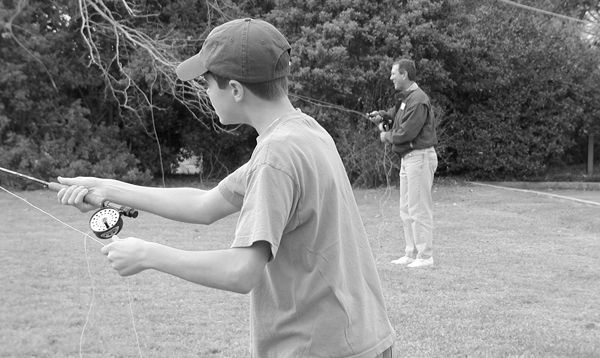
This is the month to drift the flats for outstanding trout and redfish action.
Joe Kahler and I were at the Little Missouri River recently, one of two coldwater trout fisheries less than 3 hours north of Shreveport. Stocking season was in full swing, and for fly rodders, the newly arrived fish were easy pickings.
Well, not for all fly rodders.
Twelve-year-old Brett was having a tough time with his new tackle. He’d spent most of the afternoon at this particular hole, and had not one fish to show for his efforts.
“How ya catching all those fish, mister?” his somber voice asked as the tip of my rod vibrated from the struggle beneath. “I gotta rod like you, but I don’t know what I’m doing wrong.”
His words tore my heart out. Fortunately for Brett, on Cormier’s planet it’s the sworn duty of every fly fisher to pass our sport on to others, and help them succeed. Especially youngsters.
I waded back to where he was standing, and it didn’t take long to diagnose his situation. For starters, he was using one of those cheap plastic-wrap outfits. The heavy fiberglass rod was 8-feet-long but only had five guides. It took four false casts just to get 20 feet of line out.
On the end of his fly line was a 3-foot mono leader, of which the butt section was as coiled and thick as weed trimmer line. It had more knots than a boy scout ties in a year.
Brett explained that the leader was tied by a fly rodder he met, and most of it broke off when it got hung up in a tree.
Note to everyone: Never tie a leader for someone; rather, show them how to tie a leader. Keep it simple. Keep the knots simple. No 12-year-old is going to be impressed by your grand expertise.
After cutting off Brett’s leader, I helped him tie a few feet of 12-pound-test to his fly line (butt), then showed him how to connect 6-pound-test for a tippet using a surgeon’s knot. Not the best leader, but simple and easy to remember.
Then I tied on an olive wooly bugger, and affixed a strike indicator 18 inches above the fly. I aided Brett with his casting — that needed a little work also — until finally he was able to make a good cast to a good spot.
The strike indicator only stayed afloat for about two seconds before it plunged under. I yelled, “Hit him,” but the kid had already taken action. A minute later, a decent 12-incher came alongside his hip boots. That last hour of daylight would see four more trout slip into Brett’s net.
Fishing as a whole is on the decline. The reason? According to the Recreational Boating and Fishing Foundation, youngsters from a growing number of single family homes, like Brett, are unlikely to ever take up fishing. Even if they try it, staying with it will depend on early success — actually catching a fish.
You can bet your sweet bippy groups like PETA know that. They’re doing everything in their power to reach out to these kids. We as fly fishers have to meet the challenge. It starts now.
1) Identify the opportunities. Boy Scouts now have a fly fishing merit badge; find out if anyone is helping them earn it. Some churches have youth programs; fly tying is certainly something to offer. Sporting goods stores occasionally have clinics; offer to do one. Colleges have leisure courses; offer to teach one.
2) Clubs need to be proactive. Does your club hold beginner classes, which are open to the public? Is it aggressive in its community exposure? Does it offer free membership to high school and college students?
3) Teach the sport. Teach it to the fishing manager at WalMart, or your local sporting goods store. Let them know that decent tackle makes a difference. Teach those who might teach. Tell them to keep it simple. Just as a child crawls before he walks, a young fly fisher needs only to know the very basics, from which he can grow.
Hopefully I will encounter many more Bretts in days to come. And hopefully, I’ll have to help them less each time.
Club Conclaves
Everything you always wanted to know about fly fishing can be found at a “conclave.” These small expos offer programs, fly-tying demos, casting clinics, manufacturer exhibits and much more. They are often free to the public.
On Saturday, March 12, the Red Stick Fly Fishers will host a conclave in Baton Rouge at the Louisiana Wildlife and Fisheries Waddill Education Center on 4142 Flannery Road. Guest speakers include nationally renown writers and authors Nick Curcione and Pete Cooper Jr.
Cooper’s new book, Fly Fishing the Louisiana Coast, is the first of its kind. Curcione’s book, Tug O War: A Fly Fisher’s Game, is one of the best-selling books on saltwater fly fishing. More details on this event can be found at the club’s web site at www.rsff.org.
In April, the Ouachita River Fly Fishers in West Monroe will hold a conclave at Lake D’Arbonne State Park. Details of that event will soon be posted to their web site at www.orff.org.
The Contraband Fly Fishers of Lake Charles will have its annual conclave in October. This is one of the more fun events as it’s held on Lake Prien, and on occasion, a few attendees show up having caught fish that same morning. Nothing like up-to-the-minute reports.


